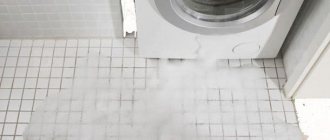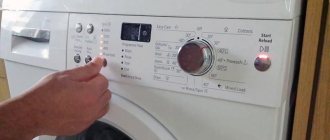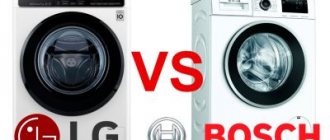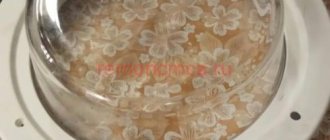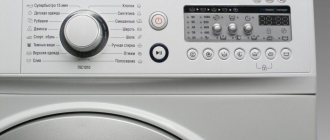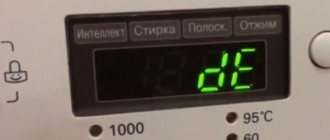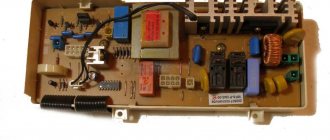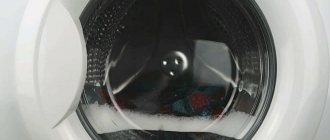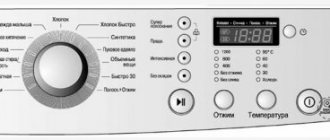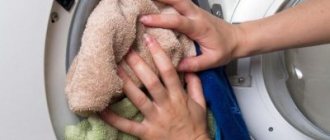Why did the breakdown occur?
If a modern machine stops working during the washing process, then usually, after a few minutes, an error is displayed on the display. By deciphering the fault code, you can find out what kind of failure occurred in the system. If the washing machine is not equipped with a display, it will notify you of a breakdown by flashing the display on the control panel.
The worst thing is when the machine does not want to show an error code. Then you will have to diagnose the equipment, eliminating one probable cause after another.
The reason for a Bosch washing machine freezing may be:
- Drum overload, imbalance. Perhaps, during the washing process, the laundry was unevenly distributed inside, and therefore the machine refuses to work further;
- random unlocking of the hatch;
- wiring damage. Sometimes some wiring gets disconnected, a terminal comes off, or a sensor breaks;
- element failure. It's probably the heater, drain pump, or motor;
- activation of the emergency leakage protection sensor;
- failure of the main control module;
- inconsistency between the washing program and the type and weight of fabric loaded into the drum (this is true for some of the latest Bosch models).
There may be problems with the drainage. So, if the filters or pipes are clogged, the machine simply cannot drain water into the sewer, and, therefore, it cannot continue to work. In addition, the filling valve may be faulty. You will have to check each element to identify the cause and repair the unit.
Bosch washing machines do not wash reasons
A Bosch washing machine may stop washing for many reasons, but of course this does not mean that Bosch washing machines are bad or generally differ from others for the worse; on the contrary, Bosch washing machines are considered one of the most reliable and unpretentious. However, the performance of equipment can be affected by a variety of factors.
If the Bosch washing machine does not wash
If your washing machine has stopped washing, it is impossible to say with certainty the reason for this, since this can happen for a number of different reasons and to identify the true malfunction, a thorough diagnosis of the system by an experienced technician is necessary. Of course, Bosch washing machines (at least most of them) are equipped with a self-diagnosis system and can independently determine the malfunction by displaying an error code on the display or by sending a certain signal with indicators, but for a number of reasons this is not always the case and, which is not uncommon, is a real problem may differ from what the error code shows. Since an error code is often a consequence of a malfunction, but not the breakdown itself.
Self-diagnosis of the washing machine
Before we talk about self-diagnosis of a Bosch washing machine, let us immediately note that the result of self-diagnosis may not always be correct, or rather, it should not be understood as a 100% cause of the malfunction; it is quite possible that this is simply a consequence of another breakdown.
So, Bosch washing machines, in addition to automatic diagnostics and displaying an error code, have a function for semi-automatic diagnostics, that is, using certain commands on the control panel, diagnostics can be carried out.
To carry out diagnostics:
It is necessary to close the door of the washing machine.
Set the washing program selection switch to the “Off” position and wait 2-3 seconds
Next, turn the switch to the “Spin” mode and the start key diode should start blinking
After this, press the speed selection key and, without removing your finger from the button, wait until the start key diode starts flashing again
Next, turn the switch to the “Drain” mode
After this, release the speed mode selection key and, using the program mode switch, begin testing the system. To do this, set the mode switch to position 1
To test individual units, move the mode switch where:
3. Checking the motor 4. Checking the drain pump (pump) 5. Checking the heating element 6. Checking the hot water inlet valve (rare in Russia) 7. Checking the cold water inlet valve 8. Checking the main wash water intake valve 9. Checking the water inlet valve Pre-wash 10. Beep check 11. Automatic test 14 and 15. Quick automatic test
To start the test, press the “Start” button of the washing machine.
To pause testing, you must press the “Start” key and turn the mode switch to the “Spin” mode
To exit the testing mode, you must press the “Start” key (if testing is in progress) and turn the mode switch to the “Off” position.
This testing can reveal a faulty unit, if there is one, however, this does not mean that repair requires replacement of this particular unit. When diagnosing a system, a technician not only looks for a malfunction, but also finds out the cause of its occurrence.
Repair of Bosch washing machines
Of course, you can independently test the washing machine and look at the description of the error code, but the right decision would be to seek the help of a specialist, since self-repair without experience and the appropriate specialized tool, as practice shows, in most cases leads to the emergence of new, even more serious malfunctions .
When contacting a service center, you can be sure that the repair will be carried out by experienced specialists, and all parts, if necessary, will be replaced with original ones, and all this will be done at affordable prices and with a guarantee!
Our contacts:
— Leave a request on the website and a manager will contact you within a few minutes — Call us — Write to us
There is a lot of garbage inside the machine
It happens that a Bosch washing machine turns off during operation due to improperly loaded laundry. Often users do not follow the manufacturer's recommendations and exceed the maximum permissible weight. Also, it could be that:
- items are not properly placed inside the drum. If they are brought together in one lump, an imbalance will arise and the machine will stop working;
- clothes are not sorted. This reason is more typical for modern Bosch machines, which can select the washing mode based on the type of fabric.
Before using the washing machine, carefully read the instructions for it.
The user manual tells you how much laundry you can load in the washer. If you can put up to 6 kg, but all 8 kg are stuffed into the drum, it is clear that the machine will “stop” in the process and refuse to work. And if the machine is equipped with an auto-weighing sensor, then the cycle will not start. Smart technology is capable of independently measuring a lot of things and displaying the value on the screen.
The machine also freezes when clothes are unevenly loaded into the machine. For example, when washing a blanket and a couple of small towels, the laundry may bunch up into a tight ball. This “ball” will press predominantly in one place, thereby disrupting the centrifugal force that occurs when the drum rotates. So it is not difficult to achieve an imbalance in which the protective sensors will certainly stop the process. In such a situation, it will be enough to straighten the accessories inside and resume the cycle.
Often the machine turns off during the washing process due to normal blockage. Garbage can “collect” in different elements:
- drain sleeve;
- pump;
- garbage filter;
- sewer pipe;
- drain pipe.
You should start with the easiest thing, so clean the garbage filter first. On Bosch washing machines it is located on the front, in the lower right corner, behind the decorative panel.
Before unscrewing the plug, cover the floor near the washing machine with dry rags, and place a basin under the bottom of the machine to collect water. Then carefully remove the filter, collect the draining liquid, and wash the part in a warm soapy solution.
Don't forget to look into the resulting drain hole. Clean out all the debris from there, wash off the dirt from the walls. Shine a flashlight inside - this way you can see the pump impeller. If there are threads, lint or hair wrapped around it, be sure to clean the blades. Afterwards, you can screw the filter back on and check whether the problem with the equipment freezing has been resolved.
If the issue is a clogged sewer, then water will not drain well not only from the washing machine, but also from the bathtub, washbasin, and toilet. You can clean the pipe yourself by using a special product, for example, “Mole” or “Tiret”. If attempts are unsuccessful, you will have to call a plumber.
When the machine turns off when full of water, you should check the drain hose. Disconnect the hose from the housing and from the siphon. Using a long wire or a special thin brush, clean the tube, rinse under the tap and put it back in place.
Sometimes the cause of equipment freezing is a clogged internal element, for example, a pump or pipes. Cleaning the drain pump is quite difficult, so it is advisable to invite a specialist for this work.
Some parts are faulty
The main components of a Bosch washing machine rarely fail, and this always happens unexpectedly. Typically, breakdowns occur during intense operation of the unit. The reason why the machine stops during the washing process may be a “burnt out” pump, a failed heating element or a broken motor. If something like this happens, the equipment immediately “freezes” and notifies the user of a malfunction.
When you see an error code on the display, immediately take the factory instructions. The manual lists the main symbols and the breakdowns they indicate. After understanding what exactly is broken, further tactics of action are developed.
When the fault code indicates problems with the engine or control module, you will have to call a technician. In this case, it will not be possible to repair the machine yourself, without experience and the necessary knowledge.
If the heater fails, you can replace it yourself. This work is not considered difficult, so it can be done at home. You need to buy an original heating element suitable specifically for your Bosch model and arm yourself with a screwdriver. By removing the top cover and back wall of the machine, you can see the element.
Next, you need to disconnect the wiring from the tubular heater, loosen the fixing nut and pull the part out. Afterwards, a working heating element is inserted into the socket, secured, and the previously discarded wiring is connected to the element. The body is assembled in the reverse order.
Before starting repairs, be sure to turn off the power to the washing machine and turn off the water supply tap.
To change the pump, you will have to lay the machine on its side, remove the part from the body, and then connect a working pump. If you have little knowledge to perform such work, it is better to invite a specialist.
Causes and solutions to the problem
If the problem with E2 arose for the first time, there is a chance that it was caused by a random combination of circumstances.
To resolve the issue, you can first reboot:
- Turn off the washing machine (pull out the plug from the socket).
- Wait 20-30 minutes.
- Restart.
If the situation with the E2 code being displayed on the display repeats immediately or after a while, the problem should not be started. The fault must be diagnosed and corrected immediately. Before this, you should not use a Bosch automatic washing machine.
Engine brush wear
The electric motor of a Bosh washing machine has two carbon brushes . They are used to transmit current to the rotating armature of the motor. Graphite is a good conductor and has lubricating properties, which ensures high-quality sliding.
With prolonged use of the washing machine, the brushes wear out and lose their functionality. As a result, the washing machine motor stops.
The following signs may indicate wear:
- an uncharacteristic noise is heard when the engine is running and sparks are even visible from under the washing machine body;
- The drum does not spin, but water is drawn in and drained without problems.
According to statistics, brush wear is the most common cause of E2.
The solution to the problem is to replace the Bosh elements that have become unusable with new ones. To carry out repair work, the washing machine is de-energized and partially disassembled to gain access to the motor. It is located under the tank.
To repair, the engine must be removed:
- First, carefully remove the drive belt.
- Disconnect the supply wires.
- Unscrew the screws holding the engine.
- The engine itself is removed.
- Squeeze out the brush contacts.
- Remove the brushes.
- Install new ones.
- Reassemble in reverse order.
Brushes are replaced two at a time, regardless of whether they are equally worn.
You can watch the video on how to replace brushes in a Bosch washing machine:
Bearing failure
The problem with the bearings is accompanied by noise and knocking when spinning clothes . Additionally, leakage may occur due to water entering the rotor bearing. Replacing the bearing can solve the problem. The final decision is made after inspecting the parts and determining their condition.
The procedure for replacing bearings can be found in the video:
Rotor axis deformation
Deformation of the rotor axis is not a rare problem. Such a violation may be accompanied by a strong noise, uncharacteristic of the normal operation of the Bosh washing machine, when the motor is running. Replacing the rotor will help solve the problem.
The tachometer is broken
A tachometer is an element of a Bosch washing machine that controls the rotation speed of the drum . If the sensor breaks down, the drum may spin at first excessively quickly, and then stop, displaying E02 on the display. To perform diagnostics, the Bosh washing machine is de-energized and partially disassembled.
The condition of the tachometer is determined by external inspection and using a multimeter. If the sensor fails, it is replaced with a new one.
Engine failure
To analyze the performance, the engine is dismantled. After this, using a multimeter, test. If the engine burns out, it is replaced with a new one.
Control unit malfunction
In rare cases, code E2 may indicate a breakdown in the Bosh control module. To analyze the condition, the unit is removed from the washing machine, having first disconnected all the wires.
Most often, the problem is solved by repair , but if the unit is severely burnt out, a complete replacement may even be necessary.
If you have no experience working with electronics, it is advisable to entrust the repair of the control unit to a specialist.
Wiring violations
A rare but possible situation where E2 may appear is a wiring fault. This error can be caused by either damaged wires or loose terminals. As a result, contact becomes intermittent and the washing machine may become unstable or stop working completely.
To find the damaged area, you need to sequentially inspect the condition of the wires . If possible, do a twist. In case of serious damage, replace it with a whole cable.
"Tweaked" with the settings
Often modern machines freeze if you set the washing program incorrectly. Therefore, before starting the mode, be sure to review the instructions for the equipment. It describes the features of various functions and their compatibility with each other.
Therefore, if the washing machine stopped working precisely while running a new mode, or a previously unused combination of options, re-read the user manual. For example, ultra-modern models, if you give them the task of soaking and bleaching things, will “freeze” during the work process. Since these two commands are written in the intellect as incompatible.
Interesting:
- Whirlpool washing machine errors without display
- Kaiser washing machine errors
- Indesit washing machine stops during washing
- Electrolux washing machine frozen
- What to do if the washing machine freezes?
- The washing machine is stuck on the spin cycle and won't stop.
Reader comments
- Share your opinion - leave a comment
